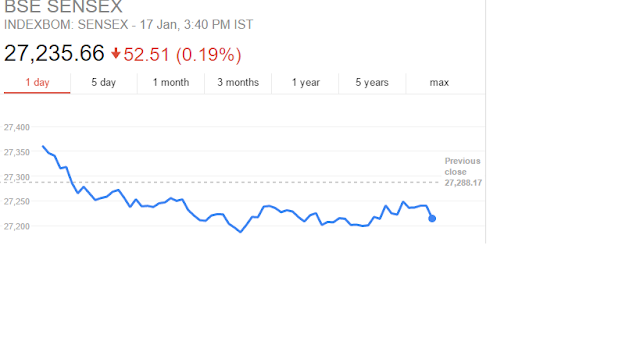Note : Any blog OR content suggestion you have , please mail me on prabhakara.dalvi@gmail.com
- 12 April 2013. Infosys corrected
by a remarkable 22%, wiping off Rs 357 billion in investor wealth. The reason:
disappointing revenue guidance.
- 17 October 2014. Tata
Consultancy Services (TCS) corrected by 8.5% in a single session. The reason:
disappointing revenue guidance.
- In Trump's first month as
president, Infosys and TCS corrected by 8% and 7% respectively. The reason:
prospects of disappointing revenue guidance.
Do you see a pattern?
The recent correction of IT
majors, though substantial, is nothing new for the sector. Nor is the reason
for the correction.
The world is speculating on a
Trump crash. So naturally, every correction to Indian IT is branded as a
fallout from the Trump crash.
But is this so-called Trump
crash a reason to act on Indian IT stocks? Of course, the answer does not
depend only on stock prices. Other factors are relevant.
So we put three key questions to
our in-house IT sector expert. Incidentally, they're the same three questions
we asked in 2013 and 2014.
Is the business model affected?
The immigration bill seeks to double the minimum salary for IT hires to
US$1,30,000 from the current US$60,000. It also seeks to make a master's degree
compulsory, among other requirements. And of course, the cost of the visa would
go up.
Now, unlike what Trump would
like to believe, Indian IT firms are no longer just back-offices to the world.
Higher-value contracts have been critical to companies for several years now.
And changing the mix of employees to comply with the requirements does no
permanent damage to their business model.
Can the risk be hedged?
Companies would need to adopt various counter measures, like hiring more
locals, getting more work done from India or other offshore locations, cutting
down on low-margin clients, and stepping up automation.
None of this is impossible to
execute. And if done with long-term interests in mind, the onetime effort may
be well worth it. So perhaps what some now perceive as a negative development
will actually be a boon for certain Indian IT players.
What's the actual impact on
fundamentals? If passed into law, the bill would put pressure on Indian IT firm
margins inFY18. The actual impact, however, may differ from company to company.
Several of them have reduced their exposure to the US in recent years. And even
the companies that would hit hardest likely have enough cash on their books to
recover from the shock.
Indian IT companies will need to
rise to Trump's challenges. But fortunately, most were already gearing up for
this. Trump may have only accelerated their defence.
So as long as you aren't worried
about the revenue guidance in the coming quarters, you need to do just one
thing: Stay vigil on valuations.
And you never know, the Trump
crash may be an opportunity to act on not just IT but lots of other safe stocks
as well.
Chart of the Day
Large Indian IT companies, on an
average generate more than 50% of their revenues from the US clients. They have
built a strong client base over the years in the US market. If the suggested
changes for immigration get cleared, the cost component for the Indian IT
companies will go up. The need to reduce their US exposure and move to other
geographies is a given.
Will Trump Mania Impact IT
Companies Revenues from US?
But we believe that it is
unlikely that the companies will substantially bring down their focus on the
US. Instead companies may look out for other means to reduce costs or protect
margins.
If you have been with us for
long, you know that we have played the gentleman's game of value
investing...and we have a solid track record of success there.
But you pay a price for this
gentlemanly approach to investing. You have to patiently wait for the bulls to
come to you. And you have to let go of many fast, raging bulls.
Substantial part of the of central government
expenditures are undertaken by state and local governments. Most states in
India like the Centre run budgets where expenditure is higher than revenue,
leading to deficits.
As reported in today's Business
Standard, the fiscal responsibility and budget management (FRBM) review
committee believes India's debt to GDP ratio will be 60% in 2023. This
comprises 40% for the Centre and the balance 20% for state governments. As per
the current available data, the outstanding debt positions of the Centre and
state governments show the combined liabilities at 69.5%.
So containing this burgeoning
debt is certainly a tall task for the government.
Generally, when the country's
growth is soaring, some portions of debt is reduced. But that is nit excatly
the case for FY17-18. The economy may continue to see impact of demonetization
for months to come. Thus the nominal GDP growth may actually be much lesser
than the projected11.75%.
The Budget has laid down large
allocations towards social welfare. But it is important for the government to
realize that while public spending is necessary, it will be important to keep
its borrowings in check. Even the RBI has warned the government about this.
In the meanwhile, after opening the day on a
flat note, the Indian share markets have continued to trade on a weak note and
are trading marginally below the dotted line. Sectoral indices are trading on a
mixed note with stocks in the pharma sector and realty sector witnessing
maximum buying interest. Auto stocks are trading in the red.
At the time of
writing, the BSE Sensex was trading down 68 points (down 0.2%) and the NSE
Nifty was trading down 24 points (down 0.3%). BSE Mid Cap index was trading up
by 0.6%, while the BSE Small Cap index was trading up by 0.8%.
Investing
mantra
"Over the long term, the
stock market news will be good. In the 20th century, the United States endured
two world wars and other traumatic and expensive military conflicts; the
Depression; a dozen or so recessions and financial panics; oil shocks; a fly
epidemic; and the resignation of a disgraced president. Yet the Dow rose from
66 to 11,497". - Warren Buffett




